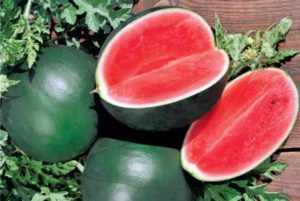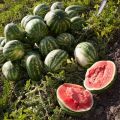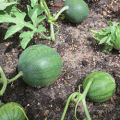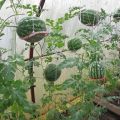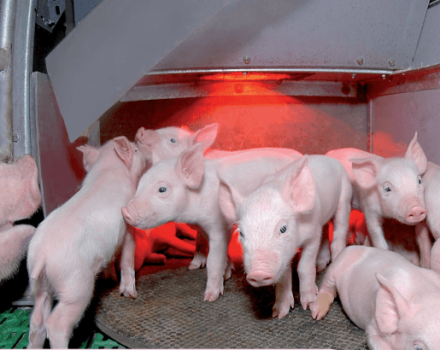Agricultural technology for growing watermelons in the open field and in a greenhouse in Siberia, planting and care
Watermelons are low-maintenance crops that are easy to grow. But the plants are also thermophilic, and give a good harvest only when grown in hot southern regions. The cultivation of watermelon varieties in Siberia is rarely successful. The climate in such regions is unfavorable for melons. It is possible to grow a berry in a greenhouse, but even so, the yield is not always high.
The best varieties for growing watermelons in Siberia
Siberia is characterized by short and cold summers, the climatic conditions in these regions are not suitable for growing melons and gourds in the garden beds. It will be possible to grow watermelons only in a greenhouse. It is also important to select a variety that is suitable for growing in unfavorable climates.
Varieties for planting in Siberia:
- Spark - the fruits of this variety grow small, up to 2 kilograms. The variety is not demanding to care for and tolerates cold summers. Spark is considered one of the most common varieties in Siberia.
- The Ultraranny variety is suitable for planting in Siberia. The growing season for this variety is 80 days. Watermelons have juicy and sugar flesh. The fruits do not grow large, there are few side lashes on the bush. Suitable for growing in glass greenhouses.
- Superearly Dyutina is a variety with large watermelons, weighing from 4 to 6 kilograms. The plant belongs to the early, the growing season is only 60 days. The peel is thin, dyed green, with light green stripes. The shelf life after collection is no more than a month

Before planting crop seeds, you must carefully read the packaging. It should indicate that the crop is suitable for growing in unfavorable climatic zones.
How to grow watermelons in a greenhouse
The secrets of growing berries in a greenhouse in Siberia should be known to every summer resident who wants to grow large and sweet fruits. It is preferable to build a greenhouse from polycarbonate.
It should be located in sunny areas, protected from strong winds. The berry does not tolerate strong winds.
You need to grow only those varieties that tolerate cold snaps. Conventional watermelon varieties will not be able to produce crops under these conditions. The optimal greenhouse height is 1.7 meters. The whips of watermelons are often twisted upward along the trellis.

Calculation of the timing of emergence
To learn how to properly care for plants, you first need to calculate the timing of seedling seedlings.In most cases, you do not need to calculate the dates yourself. The germination period is indicated on the seed package. The timing of emergence depends on the variety of watermelon.
Planting seeds
It is necessary to plant watermelon seeds in open ground in the last days of May, when the ground has warmed up by more than 14 degrees. Before planting seeds, the soil is watered abundantly.
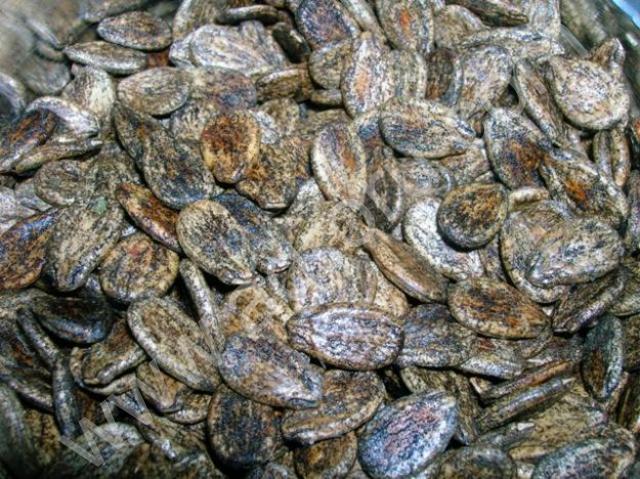
Then in the soil you need to make holes 50 centimeters wide. The depth of the hole is 10 centimeters. The distance between the holes is about 1 meter. If watermelons are planted in peat cups, then they are planted with them. The edges of the cups should protrude from the ground by 1-2 centimeters. The seedlings should not be touched for the first few weeks. You need to cover the bushes with plastic and leave. Just make sure they don't start to fade.
Growing seedlings
Before growing watermelons in a greenhouse, some summer residents prefer to plant seeds at home first and grow seedlings. Before growing seedlings, planting material must be germinated:
- Dilute a weak solution of potassium permanganate in a saucer.
- Place the seeds in the water and cover the saucer with plastic.
- Shoots appear in 2-3 days.
- After that, the planting material is planted in the soil.
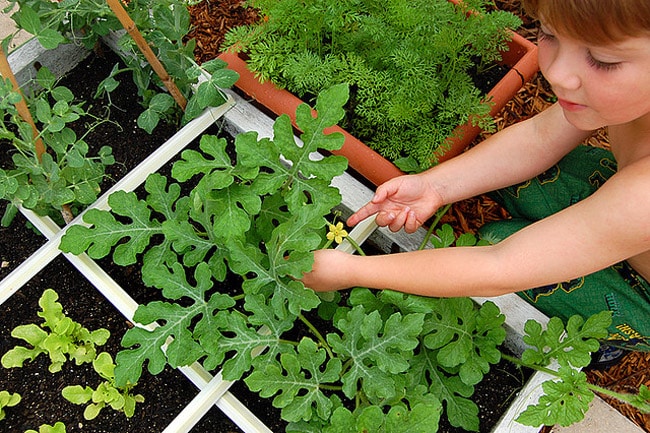
If you pre-germinate the planting material, then the sprouts of watermelons will appear much faster.
Care and watering
Watermelons must form a bush. As the bush grows, the side lashes need to be pinched. You will have to do this often. You need to leave 3-4 strong and powerful lashes, the rest are cut off. The main thing is not to touch the central shoot.
Plants need to be constantly looked after. It is important to pay attention to watering.
During active growth, the bushes require a lot of liquid. An automatic sprinkler is placed in the greenhouse and turned on daily for 3-4 hours.
Harvesting
You can understand that it is time to harvest according to several criteria:
- The peel of the fruit does not squeeze when pressed.
- A yellow spot remains at the point of contact between the peel and soil.
- If you knock on a watermelon, a dull sound is heard.
- The stalk is withered.
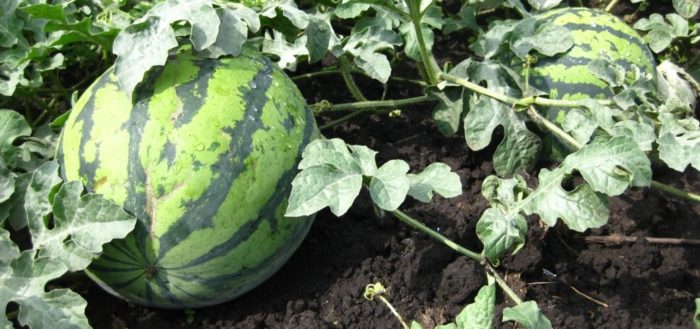
All these signs indicate that the berries need to be removed from the site.
Rules for growing melons in the open field
It is not difficult to grow melons and gourds in the country. The only problem is that outdoor watermelons grow well only in the south. It is very difficult to do this in Siberia.
Choosing a persistent, fast-ripening variety
First of all, preference should be given to early ripening varieties of watermelon. Such a feature as an early ripening period will allow you to grow a crop before the onset of cold weather.
The following varieties are suitable for growing in Siberia:
- Chill is a medium early berry variety suitable for growing in cold regions. The growing season is 80-100 days. Fruits weigh up to 4 kilograms, the shape is slightly elongated, oval. The bushes are characterized by long whips that grow up to 5 meters.
- Siberian fires is another mid-early variety, the fruits of which begin to ripen 80-100 days after planting seeds in open ground. Differs in immunity to fusarium wilt. The fruits are medium-sized, weighing from 1.5 to 2.5 kilograms. The peel is thin, dark green in color. The pulp is sweet and juicy.
- You can plant in open ground the variety Raspberry Sweet. An unpretentious variety that yields when grown in unfavorable climates. The fruits are small, up to 1.5 kilograms. The pulp is sweet, sugary.
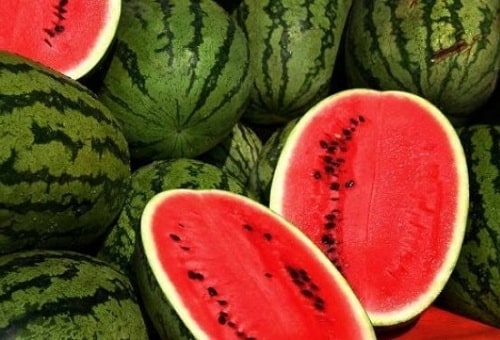
Although the varieties are suitable for outdoor cultivation, it is preferable to plant watermelons in a greenhouse.
Planting seedlings in open ground
In open ground, planting material is planted at the end of May-early June. The main thing is that the soil warms up to more than 15 degrees. If you plant seeds in cold soil, they will not sprout. The place for planting seedlings should be located in a sunny area.Bushes require a lot of space, so you need to allocate plots with a length and width of at least 3 meters for the beds.
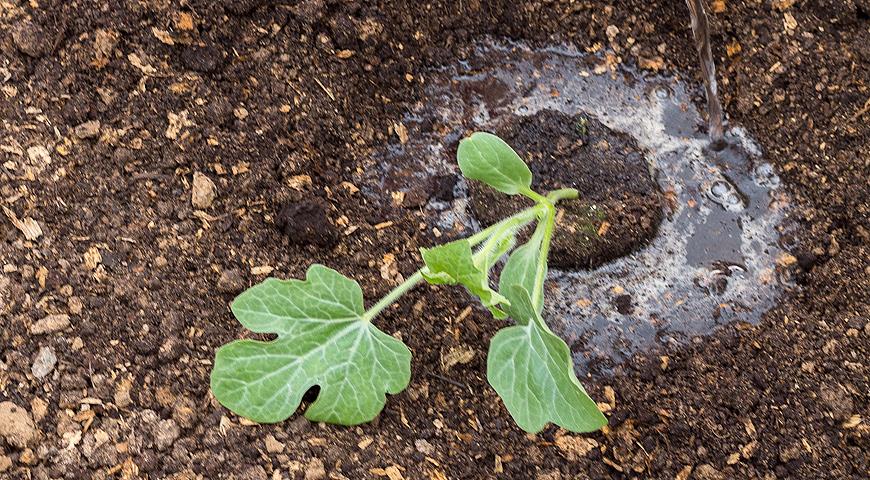
Before planting, you need to dig up the soil and add 4-5 kilograms of rotted manure. It is not advisable to use fresh manure. In addition, a complex fertilizer should be applied, which includes minerals. Planting watermelon seedlings in open ground need exactly the same as in a greenhouse. There are no differences in the planting method.
Watering and feeding
Particular attention is paid to the formation of a watermelon bush. To maximize yields, side shoots should be trimmed regularly. Only strong and powerful lashes should be left. The main thing is not to touch the central whip.
During the growth of seedlings, the bushes require a lot of liquid. Watermelons prefer sprinkling. Such watering is carried out using a hose with a nozzle.
You need to water the beds in the evening, after sunset. Water the beds every other day. When the inflorescences begin to bloom, watering is stopped. It is important to ensure that the soil does not become waterlogged.

Top dressing is important to increase yields. Nitrogen is used as mineral fertilizers. Such fertilizers are necessary to stimulate growth. Urea is sometimes used instead of nitrogen. You also need to add phosphorus and potassium to the soil. Organic fertilizers include manure, yeast-based infusions, wood ash and bird droppings.
Harvesting berries
They begin to harvest the berries when they reach biological maturity. According to the rules of agricultural technology, ripe watermelons should have a thick peel and a dried stalk. For the crop to be stored longer, it must be kept in a dark, cool room. But for more than a month, watermelons are not stored even if all conditions are met. Moreover, early maturing varieties. On the floor, you need to lay a thin layer of straw, and then lay out the watermelons. Fruits with cracks should be eaten immediately. They will not be stored for a long time.
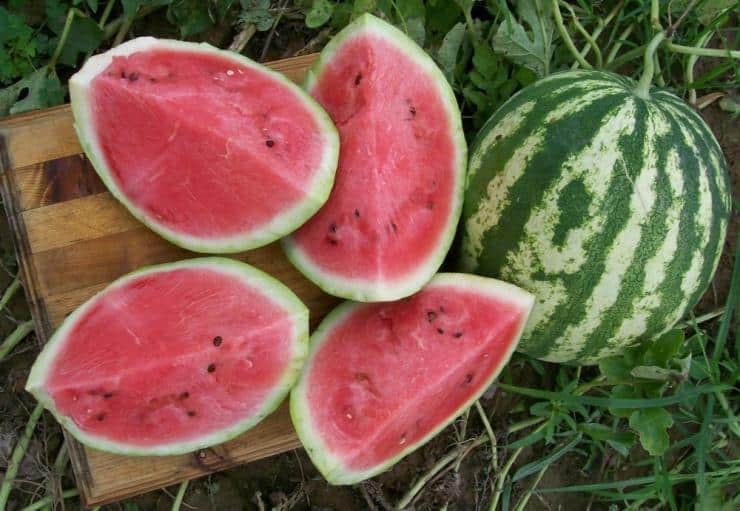
Some summer residents store watermelons in trenches, but this method is suitable for those who live in the southern regions. In Siberia, night frosts come early and can spoil the harvest.
What difficulties can you face
Since Siberia is considered an unfavorable region for growing melons, summer residents who decided to plant watermelons face a number of difficulties. Some of them are impossible to solve.
First of all, it is important to understand that Siberia has a short summer. And hot sunny days for the successful cultivation of melons are always not enough. In such conditions, only early varieties are grown, which are not very sweet. The size of the watermelon will be small. Large fruits in such a climate cannot be grown in any case. Late varieties, which are considered the sweetest, are also impossible to cultivate in Siberia.
It will be possible to successfully cultivate berries only in a greenhouse. Outdoors, plants are likely to be weak. And little ovaries will form. Growing watermelons in Siberia, although real, is problematic.

